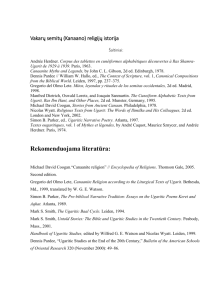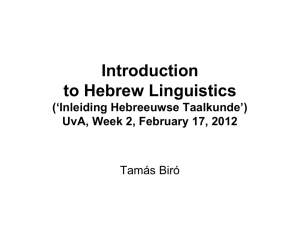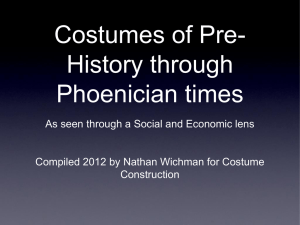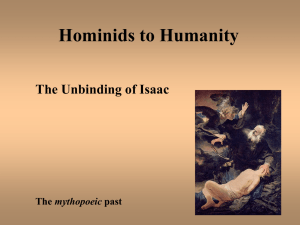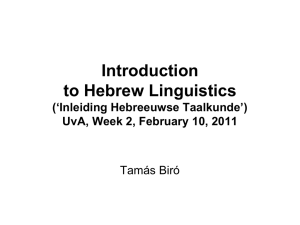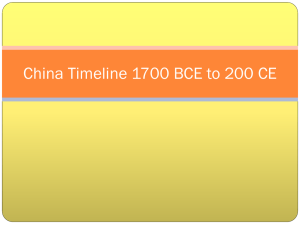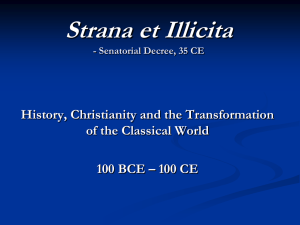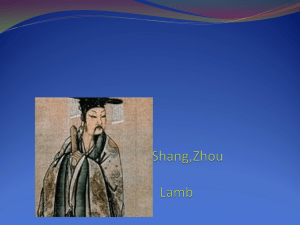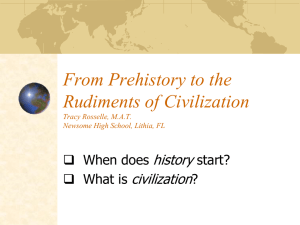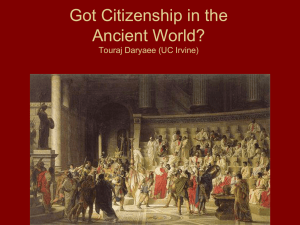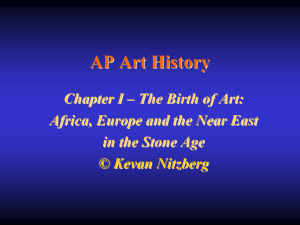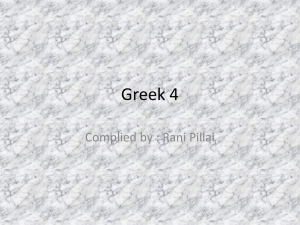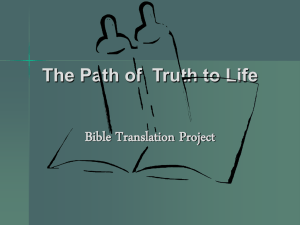ppt - Birot.hu
advertisement
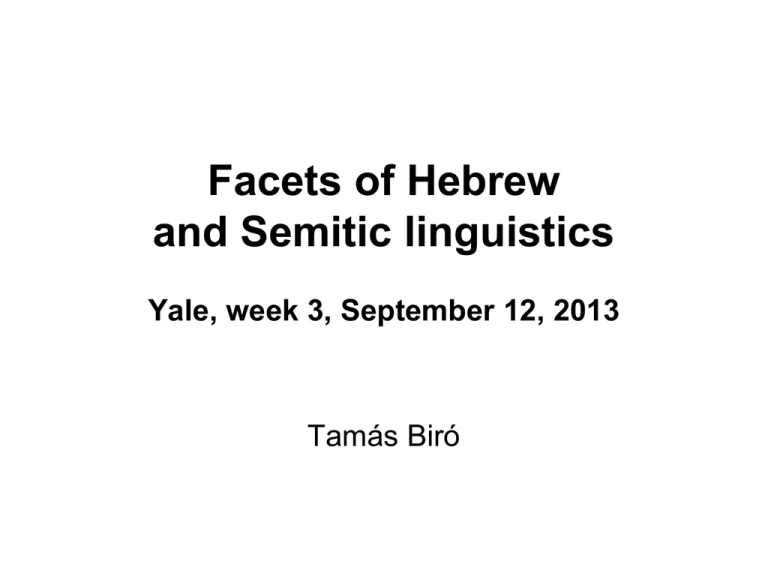
Facets of Hebrew and Semitic linguistics Yale, week 3, September 12, 2013 Tamás Biró The North-West Semitic languages Ancestors, relatives or “just” neighbors? A language continuum Semitic languages: East Semitic: West Semitic: Akkadian (and Eblaite?) South Semitic: Arabic: a (simplified) standard approach (pace Hetzron) Modern SA, Epigraphic SA, Ethiopian goes to NW (Central Semitic = Arabic + NW)? or goes to South? or separate branch? Northwest Semitic: Aramaic (older names: “Chaldean”, “Syrian”) Canaanite, Ugaritic, The West-Semitic language continuum Soon after 1000 BCE: •(Ugaritic not anymore, no Canaanite shift) •(Philistine language? Indo-European?) •Aramaic in Syria (no Canaanite shift) •Canaanite sound shift [ā] > [ō]: Phoenician on the coast, and Hebrew: Northern and Southern dialects? (E.g., shibbolet/sibbolet?) •Ammonite, Moabite, Edomite (etc?). Most probably: - spoken dialect continuum - artificial official/literary language(s) in inscriptions. Source: http://library.kiwix.org:4201/I/300px_Levant_830_svg.png The West-Semitic language continuum Hittite until 1200 BCE Ugaritic until 1200 BCE Akkadian Aramaic from 1100 BCE Arabic (Nabatean) tribes? Egyiptian Tel elAmarna South-Arabian & Ethiopian Source: http://www.aramaic-dem.org/English/History/THE_ARAMAEANS-filer/image001.jpg The North-West Semitic languages • Aramaic: 1st millennium BCE – today (Pe-history of the Israelites according to Bible: Laban; Deut. 26:5.) 11th c. BCE: Northwest Semitic tribes settling down in Syria. 10th – 7th century BCE: Old (or Ancient) Aramaic Arameans funding city states, such as Damascus. Leaving behind inscriptions, using their own script (borrowed from Phoenician script). 2Kgs 18:26 = Isa 36:11: Aramaic as diplomatic language in 701 BCE. 6th – 3rd century BCE: Imperial Aramaic (Reichsaramäisch) – Neo-Babylonian Empire and Persian (Akhaimenidan) Empire – Biblical Aramaic: Jeremiah 10:11, portions of Ezra (and of Daniel). The North-West Semitic languages • Aramaic: 1st millennium BCE – today • 3rd c. BCE – 2nd c. CE: Middle Aramaic: – Hellenistic and early Roman period (Greek in cities, later some Latin). – Main language in the Middle East. Diglossia within Aramaic. – Some Dead Sea Scrolls, New Testament, earliest Targumim (Onqelos on Torah, Yonathan on prophets), inscriptions in Jerusalem... 3rd c. CE – 9th CE (and later): Late Aramaic – Western dialect: Palestinian Jewish/Christian/Samaritan Arm. – Eastern dialect: Babylonian J. Arm (Talmud, geonic texts…) Mandean/Mandaic: secret texts of a gnostic sect in S Mesopotamia Syriac: 1st millennium CE – (today: by Syriac churches) The North-West Semitic languages • Aramaic: 1st millennium BCE – today 3rd c. CE – 9th CE (and later): Late Aramaic Syriac: Holy tongue of Syriac churches. Eastern and western varieties (of language / of script / of churches). Peshitta: Bible translation to Syriac. Transmission of the Greek culture to the Arabs. • (Medieval Jewish Aramaic: Zohar, liturgical compositions, etc.) The North-West Semitic languages • Aramaic: 1st millennium BCE – today (or yesterday?) • Today: Neo-Aramaic languages and dialects. Gradual decline of Aramaic after Arabic conquest. Islands still surviving: Syriac Christian and Jewish groups that resisted islamicization (or islamicized only recently). How long will they survive? Western Neo-Aramaic: 3 villages and in Syria, 5000 speakers (?). Eastern Neo-Aramaic: latest stages of E-Syriac, W-Syriac, etc. E and W Syrian Orthodox Christians in E Turkey, N Iraq, NW Iran. As well as Jews originating from the same region. Neo-Mandaic (Modern Mandaic) in southern Mesopotamia (Iraq, Iran; Australia and elsewhere after the first gulf war?) The North-West Semitic languages • Ugaritic: 2nd millennium BCE Ras Shamra, NE Syryia, 1928. Cuneiform alphabet, 27 C + 3 V. Major port city. Importance for biblical studies: cultural, literary and linguistic parallels. Destroyed by the invasion of the Sea People, around 1200. Abecedary from Ugarit: order had ritual importance? The North-West Semitic languages • Canaanite languages: • Hebrew: 1st millennium BCE – today • Ammonite, Edomite, Moabite: early 1st millennium BCE • Phoenician: 1st half of 1st millennium BCE Tyre, Sidon, Byblos: trade colonies (Mediterranean, Black Sea) => Punic: in Carthage (originally a colony of Tyre), 1st mill BCE in Western Mediterranean, North Africa, until late Roman times (Augustine)! • Old Canaanite: Tel el-Amarna glosses The Tel el-Amarna letters • Akhetaton: new capital of Pharaoh Echnaton (Amenhotep IV), after his religious reforms, cca. 1350. • 1887: discovery of >300 cuneiform tablets: diplomatic correspondence of Amenhotep III and Ekhnaton! • Written in Akkadian, the lingua franca of that time. • Some of them were sent by the kings of city states in Canaan to the Pharaoh: Canaanite variety of Akkadian,… • but also including glosses in the Canaanite language: – Innovations: e.g., displaying Canaanite sound shift: [ā] > [ō] – Archaic, proto-semitic features: e.g., case system (3 cases) – Cuneiform: more on vowels, but questions on consonants. • More info: http://www.tau.ac.il/humanities/semitic/amarna.html. Isoglosses in NW-Semitic Ugaritic: [ā] Case system: Nom Acc Gen Aramaic: [ā] No cases Old Canaanite: [ō] Case system: Nom Acc Gen Hebrew: [ō] No cases Problems with the family tree model • • • West-Semitic: Aramaic vs. Canaanite languages. Long debate: is Ugaritic a Canaanite language? Answers: 1. Time: You cannot compare languages from different periods. Aramaic vs. Canaanite distinction in 1st millennium, whereas Ugaritic is a 2nd millennium language. 2. Geography: - dialect continuum (remember earlier slides) - isoglosses intersect. A dialect continuum Dialect continuum Dutch: What is a dialect? Gradual change: Semi-arbitrary dialect borders: (Source of the illustrations: Wilbert Heringa and John Nerbonne) Center vs. periphery: Isoglosses Isogloss: geographical boundary of a linguistic feature (isolex for lexicon=word use, isophone for phonological=pronunciation difference, etc.). Crossing isoglosses. Area between two isoglosses: where does it belong to? Source: http://en.wikipedia.org/wiki/File:Benrather_und_Speyerer_Linie.png Source: http://nds-nl.wikipedia.org/wiki/Ofbeelding:Ikich-Isogloss_-_Uerdinger_Lien.svg The Rhenish fan Source: http://courses.essex.ac.uk/lg/lg232/images/DialectMaps/Europe/RhenishFan.JPG http://en.wikipedia.org/wiki/File:Wave_Model_Schmidt.jpeg Family tree model vs. Wave model Family Tree Model (August Schleicher: Stammbaumtheorie, 1860s): - Biological analogy (Darwin). NB: Darwin influenced by linguistic analogy. - Related languages originate from common ancestor: - different “tribes” migrating to different directions - “hard” geographic boundary (hill, river, political border) between “tribes” - language change (linguistic tree ≠ genetic tree) - Explains linguistic diversification, but not convergence. Wave theory (Johannes Schmidt: Wellentheorie, 1872): - Dialect continuum; different languages in contact (cf. areal linguistics) - Innovation spreads from center in continuously weakening circles. - Peripheries (in all directions) not always reached by innovation: archaic features may survive in distant varieties of the language. - Can account for complex isogloss structures: different innovations arising in different centers, spreading in perpendicular directions, and reaching different distances. See you next Tuesday!
